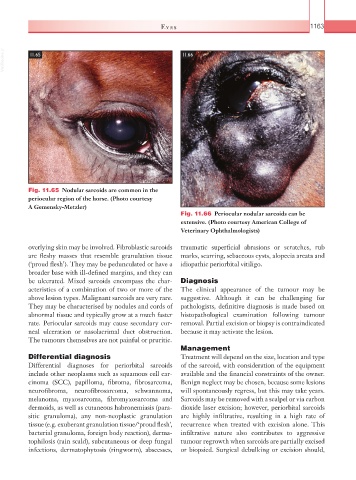Page 1188 - Equine Clinical Medicine, Surgery and Reproduction, 2nd Edition
P. 1188
Eyes 1163
VetBooks.ir 11.65 11.66
Fig. 11.65 Nodular sarcoids are common in the
periocular region of the horse. (Photo courtesy
A Gemensky-Metzler)
Fig. 11.66 Periocular nodular sarcoids can be
extensive. (Photo courtesy American College of
Veterinary Ophthalmologists)
overlying skin may be involved. Fibroblastic sarcoids traumatic superficial abrasions or scratches, rub
are fleshy masses that resemble granulation tissue marks, scarring, sebaceous cysts, alopecia areata and
(‘proud flesh’). They may be pedunculated or have a idiopathic periorbital vitiligo.
broader base with ill-defined margins, and they can
be ulcerated. Mixed sarcoids encompass the char- Diagnosis
acteristics of a combination of two or more of the The clinical appearance of the tumour may be
above lesion types. Malignant sarcoids are very rare. suggestive. Although it can be challenging for
They may be characterised by nodules and cords of pathologists, definitive diagnosis is made based on
abnormal tissue and typically grow at a much faster histopathological examination following tumour
rate. Periocular sarcoids may cause secondary cor- removal. Partial excision or biopsy is contraindicated
neal ulceration or nasolacrimal duct obstruction. because it may activate the lesion.
The tumours themselves are not painful or pruritic.
Management
Differential diagnosis Treatment will depend on the size, location and type
Differential diagnoses for periorbital sarcoids of the sarcoid, with consideration of the equipment
include other neoplasms such as squamous cell car- available and the financial constraints of the owner.
cinoma (SCC), papilloma, fibroma, fibrosarcoma, Benign neglect may be chosen, because some lesions
neurofibroma, neurofibrosarcoma, schwannoma, will spontaneously regress, but this may take years.
melanoma, myxosarcoma, fibromyxosarcoma and Sarcoids may be removed with a scalpel or via carbon
dermoids, as well as cutaneous habronemiasis (para- dioxide laser excision; however, periorbital sarcoids
sitic granuloma), any non-neoplastic granulation are highly infiltrative, resulting in a high rate of
tissue (e.g. exuberant granulation tissue/‘proud flesh’, recurrence when treated with excision alone. This
bacterial granuloma, foreign body reaction), derma- infiltrative nature also contributes to aggressive
tophilosis (rain scald), subcutaneous or deep fungal tumour regrowth when sarcoids are partially excised
infections, dermatophytosis (ringworm), abscesses, or biopsied. Surgical debulking or excision should,

